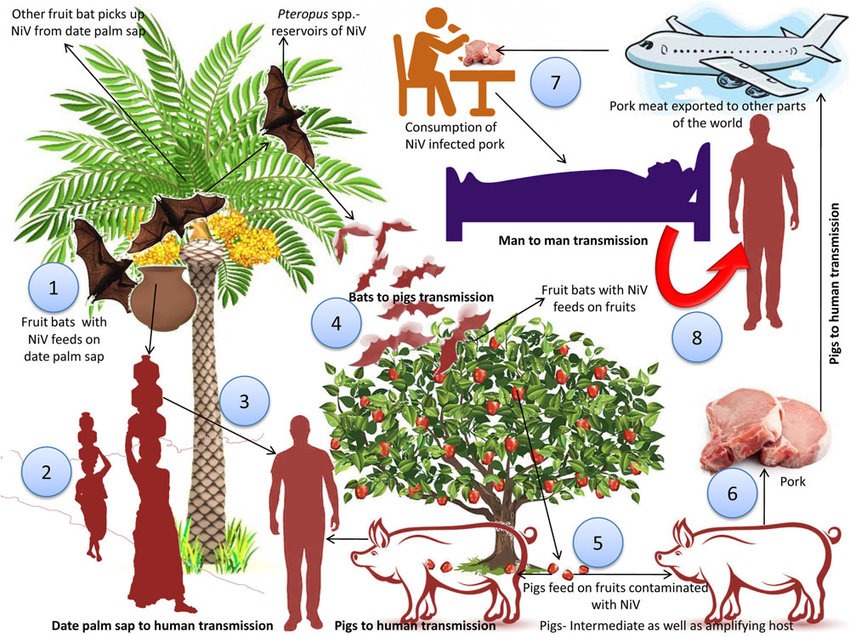Nipah breaks out again in Kerala, claims 2 lives
Context
Two deaths from the viral infection were reported from the Kozhikode area, bringing the Nipah scare back to Kerala.
The deaths were verified on Tuesday by Mansukh Mandaviya, the union minister of health. Two other cases of the virus, which spreads from person to person and from animal to human, including bats and pigs, have been identified.
What is the Nipah Virus?
- The Nipah virus (NiV) is a virus that affects both humans and pigs and causes encephalitis, or brain swelling. Mild to severe disease, and even death, might result from it. Although it can potentially spread through pigs and other animals, NiV is primarily disseminated by fruit bats.
- In 1999, following an outbreak in Malaysia and Singapore, NiV was initially identified. It first appeared as a respiratory and neurological condition in pigs that later spread to people who handled diseased animals. NiV may have emerged as a result of agricultural growth and intensification, according to research.
- Nearly every year, NiV encephalitis outbreaks have been reported in regions of Asia, particularly in Bangladesh and India. In recent years, outbreaks have also happened in the Philippines, Malaysia, and Singapore.
- In the UK, NiV is categorized as an airborne, highly contagious disease. Transmission from person to person has been documented.
When was the last time the Nipah virus was reported in India?
- On May 19, 2018, news of the final Nipah virus (NiV) outbreak in Kerala, India, was released. This was South India’s first NiV outbreak.
- A Malaysian and Singaporean outbreak in 1999 led to the initial identification of the Nipah virus. Over 100 fatalities and approximately 300 human cases were the effects of the outbreak.
Where is the present case of Nipah being reported?
- In the Kerala district of Kozhikode, there were two documented deaths caused by the Nipah virus. Both August 30 and September 11 saw the deaths. The virus has been confirmed in two more cases.
How is this virus being transmitted from Person to Person?
- Humans can contract the Nipah virus from animals like pigs or bats. Also, it can spread from person to person.
- The Nipah virus can be spread by contaminated food or directly from person to person and has a rather high case-fatality ratio, according to the World Health Organization (WHO).
What are the precautions taken by the Government to curb Nipah?
- Isolation and Quarantine: Patients who have been diagnosed as having the Nipah virus are quarantined to stop the spread of the sickness. It’s common practice to confine and watch for signs in close contact with sick people.
- Contact Tracing: To find and isolate those who may have had close touch with infected patients, health authorities conduct in-depth contact tracing. This reduces the risk of subsequent cases.
- Public Awareness: The government runs programs to inform the public about the Nipah virus, its symptoms, and protective measures. Included in this are tips on maintaining good personal cleanliness, avoiding sick people, and avoiding fruits and uncooked date palm sap that have been contaminated with bat excrement.
- Use of Personal Protective Equipment (PPE): To prevent infection, healthcare professionals and others who come into close contact with patients are given the proper PPE.
- Surveillance: To track the virus’s transmission, increased surveillance is carried out. This entails keeping an eye out for any unusual sickness patterns and swiftly testing suspicious cases.
Conclusion
The government must act quickly and decisively to stop the Nipah virus’s spread and safeguard the public’s health. For the citizens of the impacted area, it is vital that they monitor the situation and adhere to the health professionals’ recommendations.





